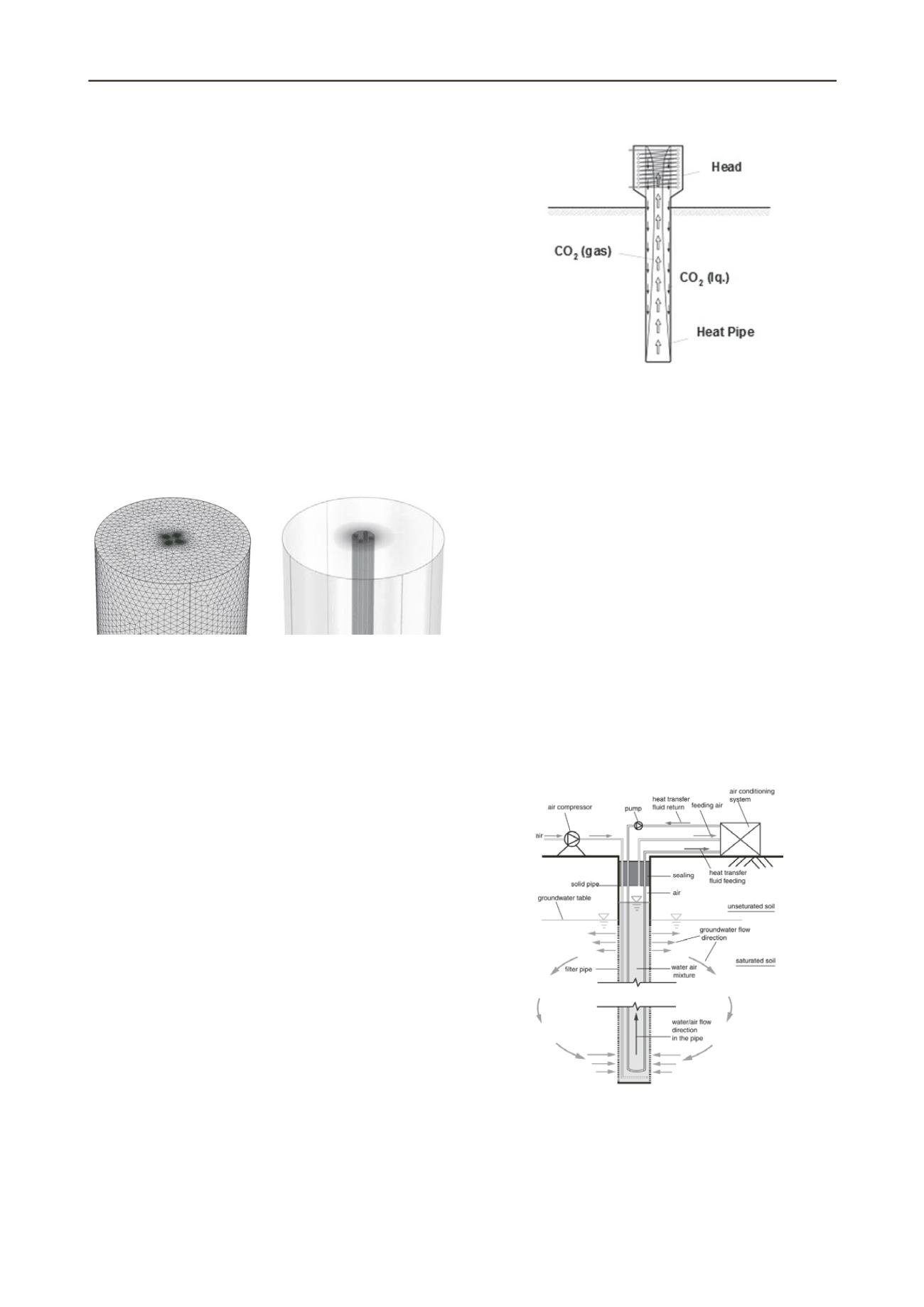
3339
Technical Committee 307 + 212 /
Comité technique 307 + 212
Bidarmaghz et al. studied the effects of different design
parameters such as pipe configuration and fluid flow rate on the
rate of heat extraction, and provided information that may aid
engineers to design an energy-efficient and cost-effective
ground heat exchanger (GHE) system. Finite element analyses
were performed, as shown in Figure 10, to model different pipe-
loop configurations, fluid flow rates and pipe separation, and to
investigate their impacts on the total system efficiency.
Based on the analysis results on a large diameter borehole
and for a given borehole length, Bidarmaghz et al. concluded
that, as long as the same pipe length is embedded inside the
borehole, thermal performance of the system is not significantly
affected by pipe geometry placement. In small diameter ground
heat exchangers (GHEs), the use of double and double cross U-
pipe showed improved performance. The addition of a second
U-pipe to both small and large diameter GHEs achieved
significant additional (40-90%) thermal performance, and this
can lead to major cost savings when compared to single pipe
systems. The analysis also indicated that, when considering the
size of the fluid circulating pump and its operational cost,
highly turbulent fluid flow will not necessarily result in a more
efficient system.
(a)
(b)
Figure 10. Typical finite element model section: (a) mesh of a GHE
with two U-pipes; (b) details of temperature distribution (Figure 2 of
Bidarmaghz et al.).
Katzenbach and Clauss advocated the use of thermosiphon
heat pipes in place of conventional heat exchanger U-pipes in
GHEs because heat pipes eliminate the use of circulation pumps
as the energy is driven through gravity and buoyancy in heat-
pipe borehole heat-exchangers (Figure 11). The thermal
performance of a heat pipe depends on a number of factors like
driving temperature difference, mechanical and thermal
properties (e.g., enthalpy) of the heat-carrying fluid, thermal
conductivity and capacity, energy withdrawal rate on the
condenser side, the geometric dimensions, and the inside
pressure. The authors performed numerical analysis to
investigate the sensitivity of various parameters like the length
and diameter of heat pipe and borehole on the GHE
performance. They found that the relationship between length
and diameter has a large influence on the specific power (heat)
and suggested an optimization of these dimensions in design.
Katzenbach and Clauss concluded that the efficient energy
transport within the heat pipe allows a relative increase in the
coefficient of performance (COP) of 10% or more. They also
collected temperature data from an instrumented geothermal
heat pipe borehole heat exchanger system installed for new,
single-family home. The data was used to compute the expected
heat -power output and to assess the operation efficiency of the
system.
Figure 11. Geothermal heat pipe (Figure 2 of Katzenbach and Clauss).
Grabe at al. simulated the performance of a borehole heat
exchanger operated in conjunction with air-sparging induced
groundwater circulation using the multiphysics finite element
software COMSOL. Groundwater circulation around GHE
systems increases the heat-transfer efficiency because heat flow
can then happen through convection in addition to the
conductive flow that occurs in regular closed-loop GHEs. The
authors considered a three-dimensional model in which the heat
exchanger borehole is fitted with heat-exchanger and air-
injection pipes (Figure 12). They neglected flow inside the well
and heat pipes, and considered a homogeneous, sandy aquifer.
The computations were performed by assuming that the
hydraulic and thermal properties of soil are temperature
independent, which implied that groundwater flow is not
influenced by heat transport. Grabe at al. simulated the
groundwater flow till the attainment of stationary conditions.
The results obtained were superimposed with heat propagation
in soil. A parametric study was performed by varying the
density of air-water mixture inside the well, and the thermal and
hydraulic conductivities of soil. A profitability analyses was
also performed based on the numerical results. The authors
concluded that air-sparging well combined with borehole heat
exchanger increased the heat-abstraction capacity and that the
system worked well for soil with high hydraulic conductivity.
Figure 12. Combination of an air-sparging downhole heat exchanger
with an air conditioning system (Figure 1 of Grabe at al.).
Ziegler and Kürten described two examples of novel
geothermal energy utilization technique. In the first example,
the thermal utilization of smouldering mining dump in the Ruhr
area of Germany was described. Three heat-exchange fields
consisting of borehole heat exchangers and temperature gauges
were installed. Several thermal response tests determining the
short-term behavior of the plants and long-term tests were


